Plum Curculio
(Conotrachelus nenuphar)
December 2023
Kate Richardson, Extension Entomology Specialist • Marion Murray, Extension IPM Specialist
Quick Facts
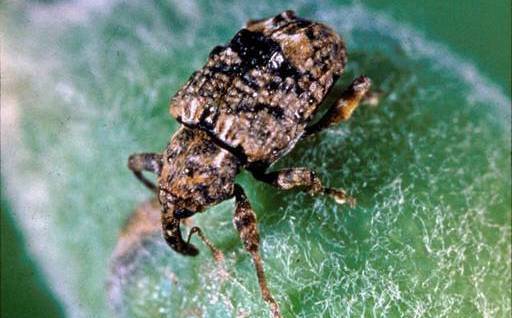
Fig. 1. Adult plum curculio.
Clemson University, USDA Cooperative Extension, Bugwood.org.
- Plum curculio is a small brown weevil that infests pome and stone fruits, including cultivated, ornamental, and wild species.
- It is native to eastern North America but was first detected west of the Rocky Mountains in Box Elder County, Utah, in the early 1980s, where it remains the only western population.
- Adult plum curculios cause fruit damage by chewing feeding holes and leaving crescent-shaped egg-laying scars. Larvae can also cause damage by tunneling in the fruit flesh.
- Effective management can be accomplished with proper monitoring techniques, sanitation practices, and insecticide applications.
Plum curculio, Conotrachelus nenuphar (Coleoptera: Curculionidae; Fig. 1), is a small brown weevil (beetle with a snout) native to eastern North America where it is a major pest of pome and stone fruits. It thrives in environments where orchards are located next to hardwood forests. In its native habitat, it feeds on wild fruits, but it has also readily adapted to cultivated orchards and ornamental fruit trees. Native hosts include plants in the Rosaceae family such as wild and cultivated plum, crabapple, cherry, and other fruit trees.
Plum curculio was detected in Box Elder County, Utah, in the early 1980s, and this population remains the only known infestation in western North America, where it is occasionally found in residential and wild fruit trees. Plum curculio is a quarantine pest in western North America (U.S. and Canada), and fruit grown in infested counties is restricted from being exported. Thus, it is a threat to Utah’s fruit industry and requires ongoing monitoring and management to keep Utah’s fruit export markets open.
Description and Life History
Plum curculio adults are 1/4 inch long with a brown to black body overlaid with light gray and brown markings along a rough back. They are recognized as a weevil by a long, slightly curved snout. Their chewing mouthparts are located at the end of the snout.
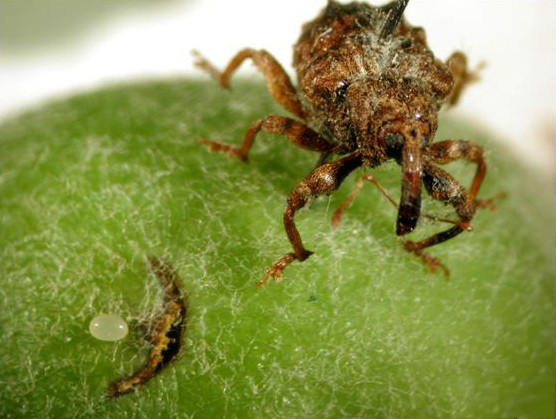
Fig. 2. Plum curclio egg and oviposition (egg-laying) scar (left) and adult (right). Peter Jentsch, Cornell University’s Hudson Valley Lab.
Adults overwinter in protected areas, where they burrow under leaf litter in wooded areas, ditch banks, fence rows, and compost piles near host orchards. In spring, they become active when mean ambient temperatures exceed 50 °F for at least 3 days, and move into orchards when maximum temperatures exceed 70 °F. Adults primarily move by walking when temperatures are below 70 °F but may fly into host trees at warmer temperatures (Alston et al., 2016).
A female plum curculio will chew a small cavity under the fruit skin and deposit a small, white, oval egg into the cavity (Fig. 2). The female then cuts a crescent-shaped slit beneath the egg, leaving a flap of skin and flesh to cover the egg. This protects the egg from being crushed as the fruit expands in size. In their native range, females lay an average of 150 to 200 eggs in their 12-month lifespans (Eaton & Maccini, 2016), and egg-laying is highest during warm and humid evenings. Eggs typically hatch in 2 to 12 days.
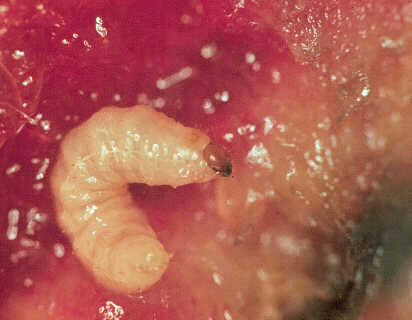
Fig. 3. Plum curculio larva in peach fruit flesh.
Peter Jentsch, Cornell University’s Hudson Valley lab.
Eggs hatch into legless, gray-white grubs (larvae) that have curved bodies and small brown heads. The hatched larvae feed within the fruit flesh, requiring 8 to 22 days to complete their four larval stages. When fully grown they can reach 5/16 inch (Fig. 3).
Mature larvae will exit fruit, drop into soil, and construct a small cavity 1 to 3 inches deep in which to pupate. Pupae are white, about 3/16 inch long, and complete development in 12 to 16 days.
Complete development from egg to adulthood requires 5 to 8 weeks, depending on environmental conditions. In Utah, plum curculio only completes one generation per year (Fig. 4). Adults that emerge from pupation during late summer/early fall feed on host fruits, causing later-season damage, and then move to overwintering sites as the days shorten.
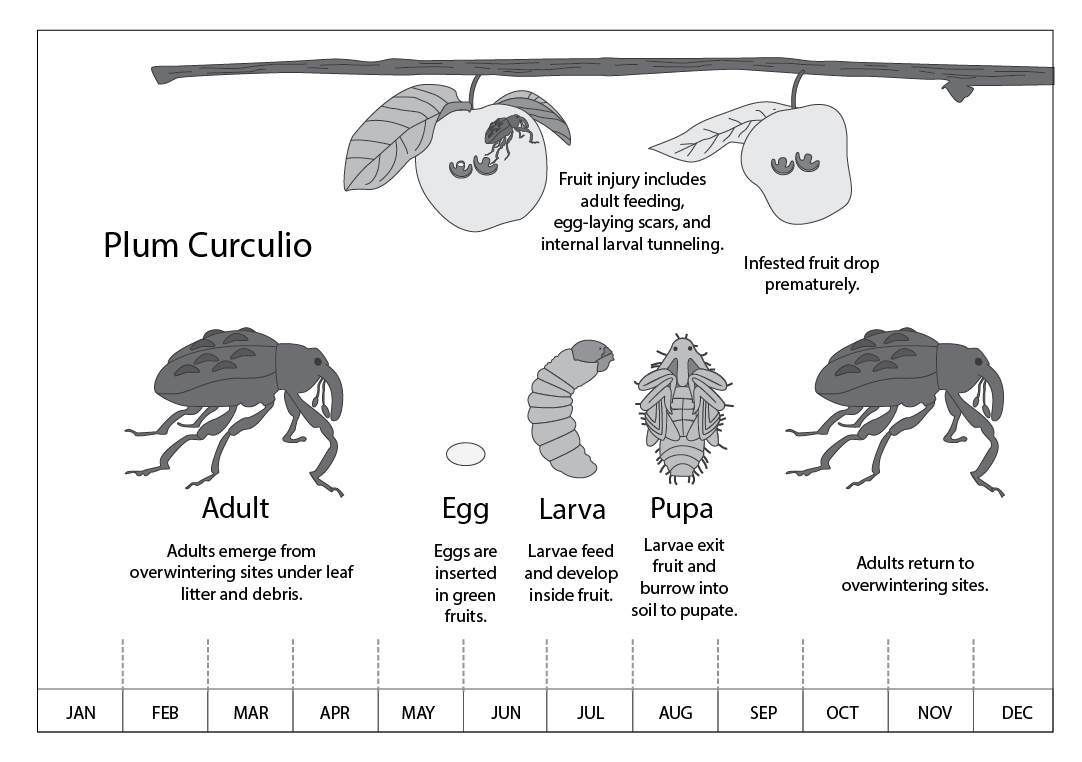
Fig. 4. Life cycle of plum curculio in Utah, exhibiting one generation per year. Utah State University Extension.
Host Plants and Damage
Plum curculio has a fairly wide host range within the Rosaceous family, with wild plums being the most preferred in Box Elder County, Utah (Table 1). In apple and pear, egg-laying scars occur, but the larvae do not survive the pressure of the growing fruit. No economic damage has occured on apples or pears in Utah.
| Pome and Stone Fruits | Ornamental and Wild Fruits |
|---|---|
| Apple | Black cherry |
| Apricot | Common deerberry |
| Nectarine | Crabapple |
| Peach | Currant |
| Pear | Gooseberry |
| Quince | Hawthorn |
| Sweet cherry | Laurel cherry |
| Tart cherry | Mayhaw |
| Sand cherry | |
| Saskatoon/western service berry | |
| Wild plum |

Fig. 5. Plum curculio damge on apples.
J. Hahn, University of Minesota.

Fig. 6. Plum curculio oviposition scars on
apple.
Cornell University IPM Program.
Adults feed on fruit by chewing small, round holes. Early-season feeding causes fruit to be deformed at harvest (Fig. 5). Feeding wounds may allow for the invasion of fungal pathogens such as brown rot, increasing the severity of crop loss.
Adults indirectly damage fruits through oviposition (egg-laying). These scars have a crescent shape with slits about 1/4 inch long, forming a noticeably darkened scab on the fruit surface (Fig. 6).
In most cases, fruits will have both feeding and oviposition scars on the fruit’s surface (Fig. 7). On peaches, these wounds may appear as shiny areas of disturbed fuzz. In addition to the fruit, adults will feed on leaves, buds, flowers, and stems, but this damage often goes unnoticed.
Larvae cause damage by tunneling within the fruit flesh, making it unfit for consumption. Most infested fruits abscise and drop to the ground prematurely. Fruits that remain on the tree are deformed and may rot during ripening (Fig. 8).
Larvae in pome fruits are usually killed by the expansion of the flesh. In stone fruits, larvae that survive to maturity chew a hole to exit the fruit, leaving frass (excrement) on the fruit surface.
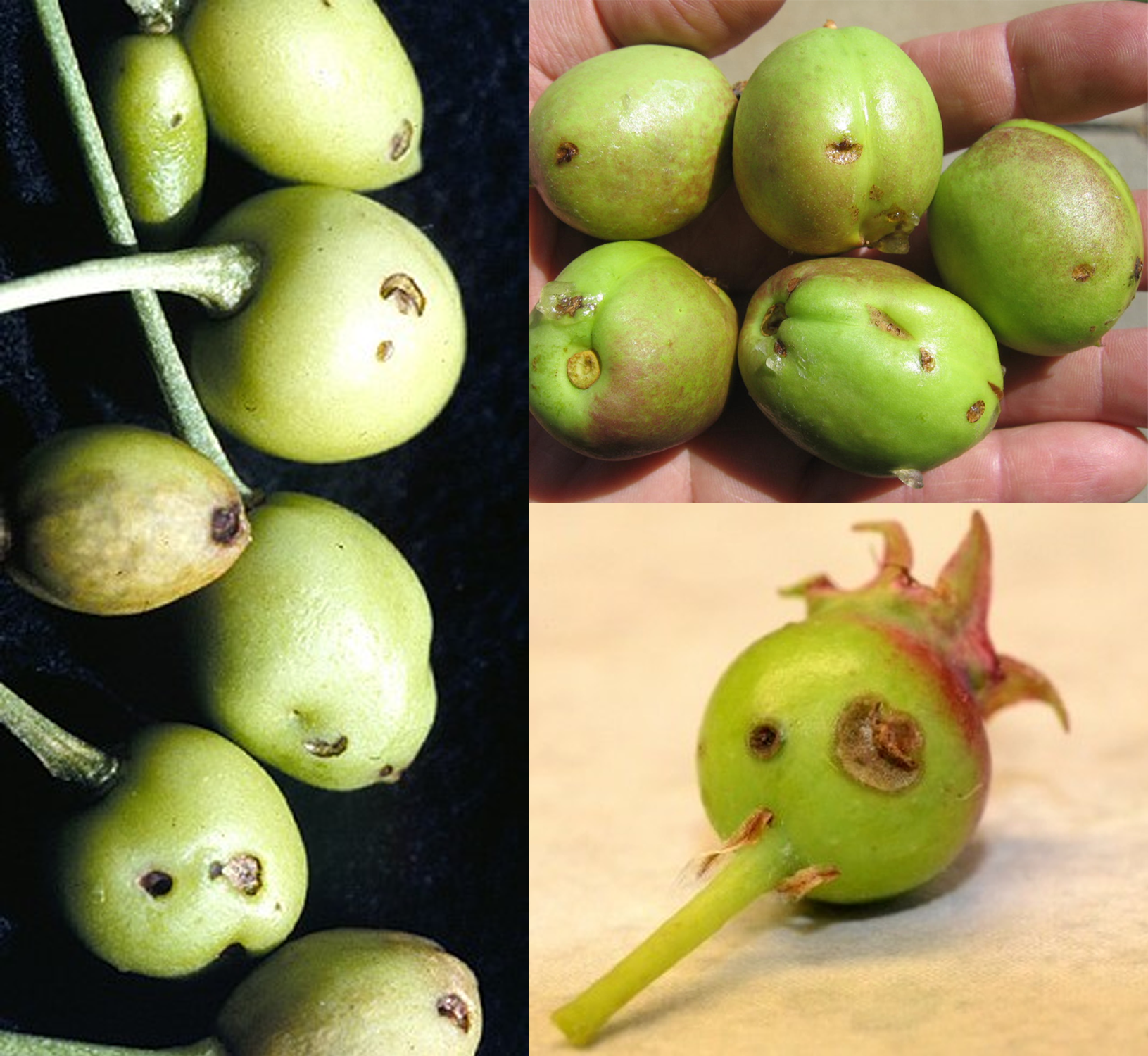
Fig. 7. Plum curculio feeding and egg-laying damage on cherries (left; Utah State University Extension), nectarines (upper right; Michigan Plum Growers), and saskatoon/western serviceberry (lower right; Michigan State University).
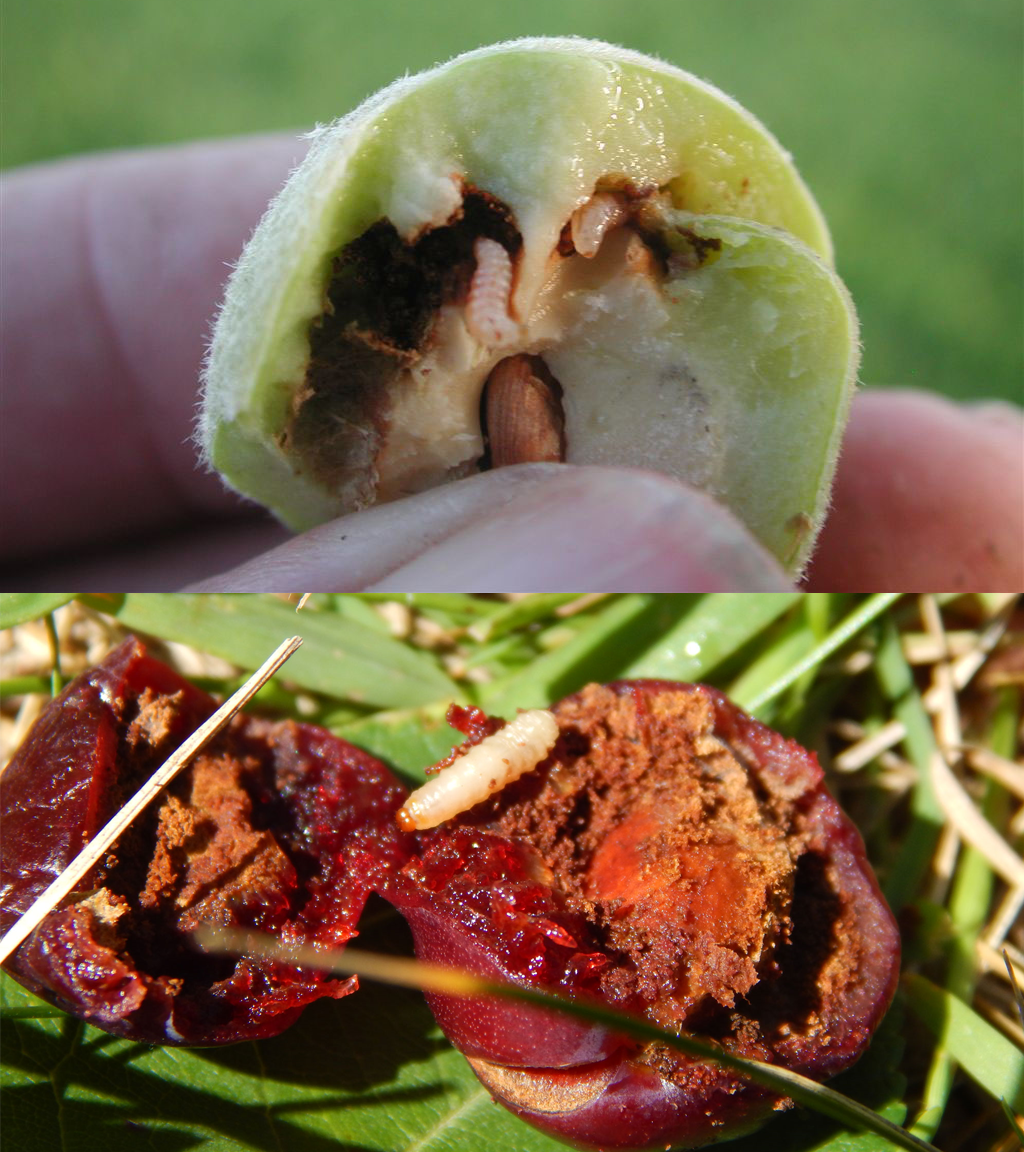
Fig. 8. Plum curculio larvae causing damage in a young
peach (top; Texas A&M Extension) and rotting in cherry
(bottom; Thaddeus McCamant, Central Lakes College).
Monitoring
The Utah Department of Agriculture and Food conducts an annual statewide monitoring program to track the spread of plum curculio. Backyard and commercial producers can also monitor for this pest.
Crucial monitoring periods occur when ambient temperatures reach or exceed 70 °F during shuck-split in stone fruits and petal-fall in pome fruits. In orchards with a history of plum curculio injury, monitoring should be conducted two to three times per week during critical periods. Select representative locations throughout orchards to detect adults or injury before economic crop loss occurs (Table 2).
| Life Stage | Timing | Habitat |
|---|---|---|
| Adult | Spring when temperatures exceed 60 °F | Orchards next to woodlots and hedgerows. Feeding injury is typically the first sign of adult presence. |
| Adult | Late July to early fall when temperatures drop below 60 °F. | Orchard edges and surrounding habitat as adults move out for winter hibernation (diapause). |
| Eggs | Beginning at approx. petal fall and continuing for approx. 30 days. |
Young fruits with cresent-shaped oviposition wounds. |
| Larvae | Early June through mid-July. | Injured fruit attached and dropped from the tree. |
Visual
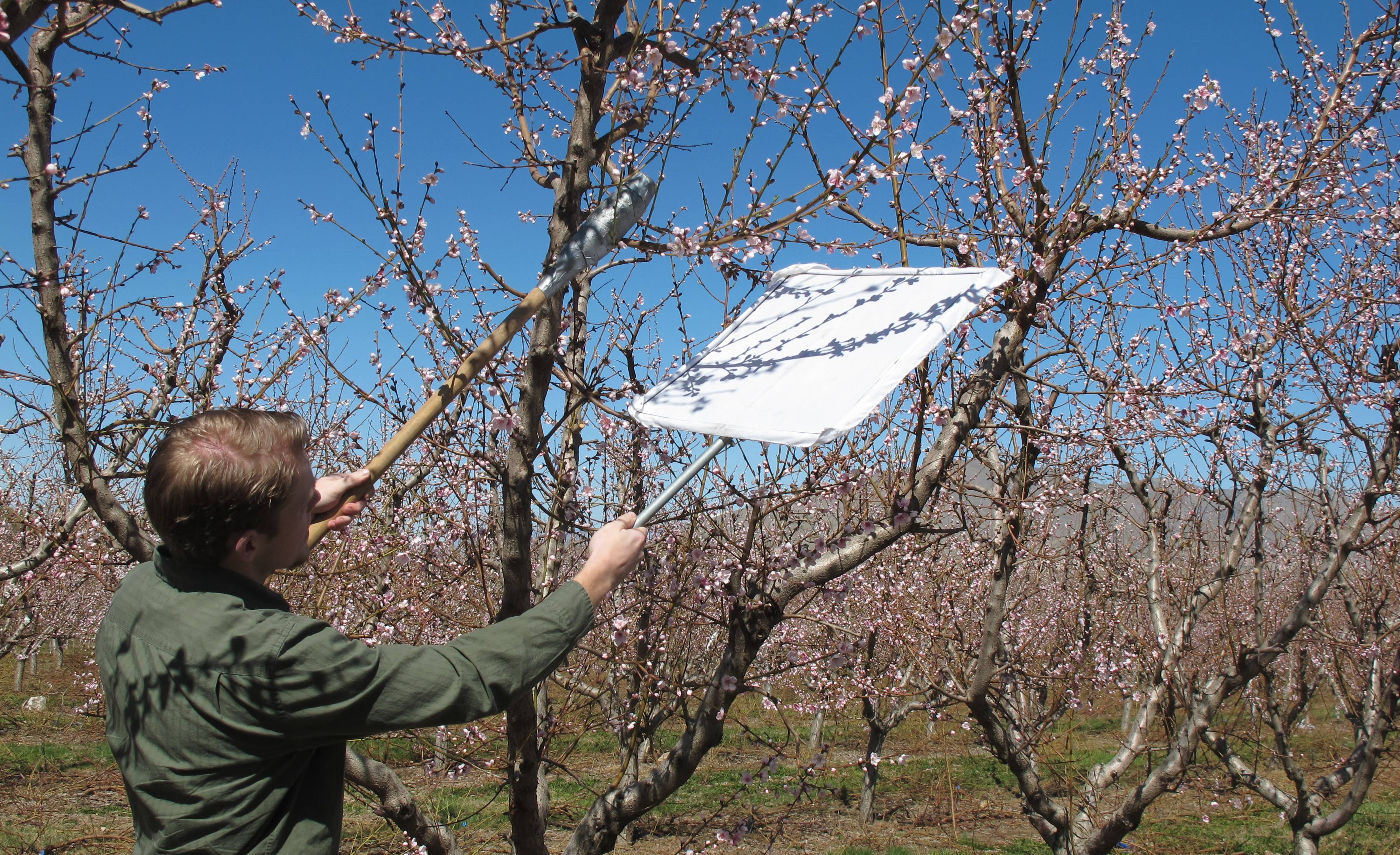
Fig. 9. Sampling for plum curculio using a beating tray and stick.
Utah State University Extension.
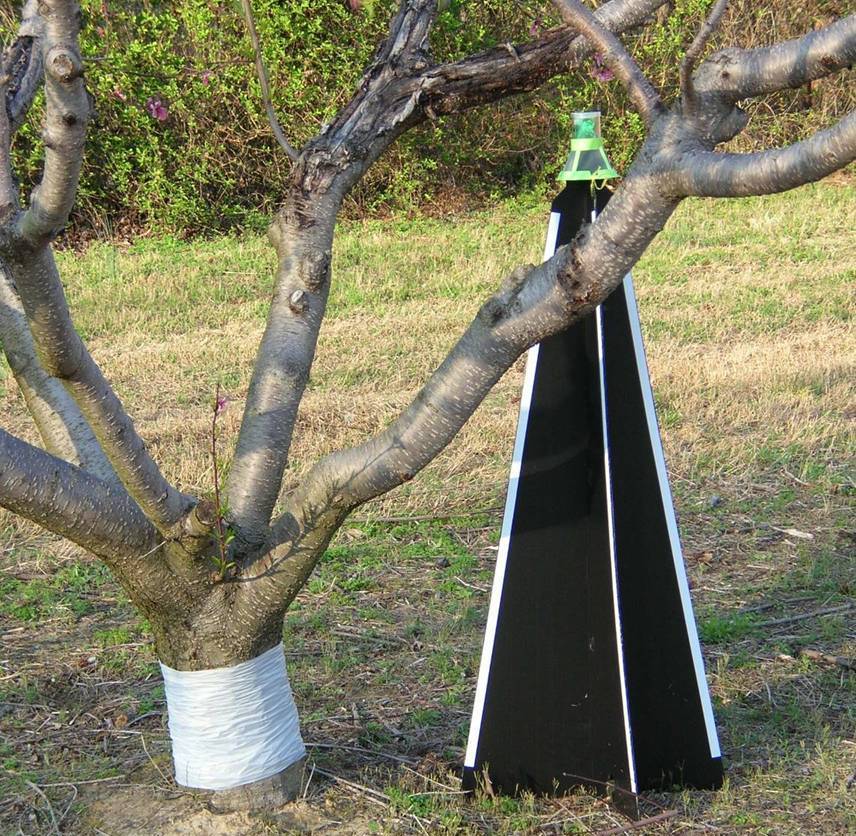
Fig. 10. Black pyramid trap placed at field border to monitor for plum curculio. R. Boozer, Alabama Extension.
Visual inspections should focus on adults and fruit injury. To look for adults, vigorously shake or beat branches over a tarp or beating tray (Fig 9). The beating or shaking action will dislodge plum curculio adults onto the sampling surface for observation and counting. The best time to monitor for adults is early morning when temperatures are cooler and adults are less active and less likely to fly away. Adults tend to congregate near edges, especially in the spring as they disperse into orchards from overwintering sites.
When monitoring fruit for damage, inspect 100 fruits along orchard borders and look for:
- Round feeding holes from adults.
- Deformed fruit at harvest from surface feeding of overwintered beetles.
- Tan, discolored, or scarred crescent shapes on fruit skin from egg-laying injury.
- Internal fruit injury from burrowing larvae.
- Premature fruit drop.
- Fruit with areas of rot.
Traps
Beginning at early bloom, pyramid traps can be baited with benzaldehyde lures (Fig. 10) in the outer rows of orchard trees adjacent to woodlots. Initially, check traps weekly, then twice weekly when adult captures become frequent or by petal fall. Visual sampling can be adjusted for fruit injury as dictated by adult captures in beating tray samples and/or traps. A trap threshold of 0.1 adults per trap per day suggests an insecticide application is recommended. Contact the Utah Department of Agriculture and Food if you are interested in placing a trap in your orchard.
Management
The most common management tactic for plum curculio is applying one to three insecticide treatments per season (depending on population severity and application timing). Additionally, the use of nonchemical tactics can greatly improve suppression and may reduce the number of sprays and cost of control.
Cultural Control
Good sanitation practices will help reduce local plum curculio populations. Removing wild and ornamental fruit trees growing near orchards will reduce harboring populations and appropriate habitats. Communication with neighbors may be necessary to facilitate this effectively. It is also important to remove fallen fruit during the summer in an infested orchard. Fruit on the ground can be collected and fed to animals or disposed of in the trash. Larger fruit may be chopped with a flail mower.
Mechanical and Physical Control
Shake or beat tree limbs and trunks with a padded stick or mechanical shaker to dislodge plum curculio adults onto tarps where they can be collected and destroyed. Mechanical control is labor-intensive and best suited to small-scale and organic orchards.
Biological Control
Entomopathogenic nematodes that target plum curculio ground-dwelling stages can help reduce populations. In a study done by Shapiro-Ilan et al. (2013), Steinernema riobrave applied to soil under infested trees was effective at suppressing populations, while S. feltiae killed plum curculio at a lower rate. This method provided economically feasible control by decreasing pesticides while maintaining control. Studies in Utah found a native population of Heterorhabditis bacteriophora (EPN) in plum curculio-infested soils of Brigham City, Utah (Kim and Alston, 2008). Although the nematodes attacked plum curculio larvae and pupae and reduced populations readily in the laboratory, satisfactory field control was not achieved by relying on nematodes alone.
Chemical Control
Chemically controlling plum curculio may be necessary depending on damage severity in previous years. Insecticides are typically applied at petal fall and repeated in 7 to 10 days. A third application 7 to 10 days after the second application may be needed depending on timing and pest severity. Chemical strategies differ for commercial fruit production (Table 3) and home fruit production (Table 4).
| Insecticide Class1 | Common Name | Example Brand | Application Timing |
|---|---|---|---|
| Carbamates (1A) | carbaryl* | Sevin XL PLus | When populations reach economic threshold |
| Pyrethroids (3A) | esfenvalerate* | Asana XL | When insects appear |
| fenpropathrin* | Danitol 2.4 EC | When insects appear | |
| lambda-cyhalothrin* | Warrior II | When insects appear | |
| pyrethrin*O | Pyganic | When insects appear | |
| zeta-cypermethrin* | Mustang | When insects appear | |
| Diamides (28); Pyrethroids (3A) |
chlorantraniliprole*; lambda-cyhalothrin* |
Voliam Xpress | Before pests reach damaging levels |
| Diamides (28); Neonicotinoids (4A) |
chlorantraniliprole*; thiamethoxam* |
Voliam Flexi | Before pests reach damaging levels Pomes: immediately following petal fall |
| Other | azadirachtin*O | Molt-X | Consult with a local specialist |
| Beauveria bassiana strain GHA*O | Botanigard ES | When insects appear | |
| Burkholderia spp. strain A396*O | Venerate XC | When newly hatched larvae are present |
| Insecticide Class1 | Common Name | Example Brand | Application Timing |
|---|---|---|---|
| Pyrethroids (3A) | gamma-cyhalothrin* | Triazicide Insect Killer | When insects appear or when damage occurs |
| pyrethrin*O | Ortho Tree & Shrub Fruit Tree Spray | When insects appear or when damage occurs | |
| Other | azadirachtin* | Safer Bioneem | When insects appear or when damage occurs |
- Alston, D., Spears, L., & Burfitt, C. (2016). Chapter 5: Plum curculio. In Invasive fruit pest guide for Utah (pp. 65–75). Utah State University Extension.
- Breth, D. I., Shaw, M., Fargione, M., Reisinger, R., Eve, J., Hoyin, S. S., Jentsch, P., & Tee, E. (2014). Chapter 10: Plum curculio. In Apple IPM for beginners (pp. 28–29). Cornell University Cooperative Extension.
- Kim, H. G. & Alston, D. G. (2008). Potential of two entomopathogenic nematodes for suppression of plum curculio (Conotrachelus nenuphar, Coleoptera: Curculionidae) life stages in northern climates. Environmental Entomology, 37(5), 1272–1279.
- Lampasona, T., Rodriguez-Saona, C., Leskey, T., Nielsen, A. (2020). A review of the biology, ecology, and management of plum curculio (Coleoptera: Curculionidae). Journal of Integrated Pest Management, 11(1), 22.
- Leskey, T. C., Pinero, J. C., & Prokopy, R. J. (2008, August 1). Odor-Baited trap trees: A novel management tool for plum curculio (Coleoptera: Curculionidae). Journal of Economic Entomology.
- Lienk, S. E. (1980). Plum curculio, Conotrachelus nenuphar (Herbst) [Tree Fruit IPM, Insect Identification Sheet No. 3]. New York State Agriculture Experiment Station.
- Shapiro-llan, D. I., Wright S. E., Tuttle A. F., Cooley, D. R., & Leskey, T. C. (2013). Using Entomopathogenic nematodes for biological control of plum curculio, Contrachelus nenuphar: Effects of irrigation and species in apple orchards. Biological Control, 67(2), 123–129.
- Whalon, M., Nortman, D., Wise, J., Gut, L., & Epstein, D. (2007). Plum curculio management and spray timing. Michigan State University Extension Department of Entomology.

